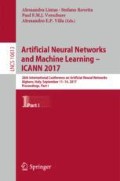Abstract
In the context of Developmental Robotics, we propose to learn how the sensations of a robot are modified by its action. Many theories of Artificial Intelligence argue that sensorimotor prediction is a fundamental building block of cognition. In this paper, we learn the sensorimotor prediction on data captured by a mobile robot equipped with distance sensors. We show that Neural Networks can learn the sensorimotor regularities and perform sensorimotor prediction on continuous sensor and motor spaces.
Access this chapter
Tax calculation will be finalised at checkout
Purchases are for personal use only
References
Abadi, M., et al.: TensorFlow: Large-scale machine learning on heterogeneous systems (2015). software available from tensorflow.org
Cangelosi, A., Schlesinger, M.: Developmental Robotics: From Babies to Robots. The MIT Press, Cambridge (2014)
Clark, A.: Whatever next? predictive brains, situated agents, and the future of cognitive science. Behav. Brain Sci. 36(3), 181–204 (2013)
Friston, K.: The free-energy principle: a unified brain theory? Nat. Rev. Neurosci. 11(2), 127–138 (2010)
Ghadirzadeh, A., Btepage, J., Kragic, D., Bjrkman, M.: Self-learning and adaptation in a sensorimotor framework. In: 2016 IEEE International Conference on Robotics and Automation (ICRA), pp. 551–558, May 2016
Goodfellow, I., Bengio, Y., Courville, A.: Deep Learning. MIT Press (2016)
Krizhevsky, A., Sutskever, I., Hinton, G.E.: Imagenet classification with deep convolutional neural networks. In: Pereira, F., Burges, C.J.C., Bottou, L., Weinberger, K.Q. (eds.) Advances in Neural Information Processing Systems 25, pp. 1097–1105. Curran Associates, Inc. (2012)
Levine, S., Finn, C., Darrell, T., Abbeel, P.: End-to-end training of deep visuomotor policies. J. Mach. Learn. Res. 17(1), 1334–1373 (2016)
Magnenat, S., Rétornaz, P., Bonani, M., Longchamp, V., Mondada, F.: ASEBA: a modular architecture for event-based control of complex robots. IEEE/ASME Trans. Mechatron. 16(2), 321–329 (2011)
Maye, A., Engel, A.K.: Extending sensorimotor contingency theory: prediction, planning, and action generation. Adapt. Behav. 21(6), 423–436 (2013)
Möller, R., Schenck, W.: Bootstrapping cognition from behavior - a computerized thought experiment. Cogn. Sci. 32(3), 504–542 (2008)
O’Regan, J., No, A.: A sensorimotor account of vision and visual consciousness. Behav. Brain Sci. 24(05), 939–973 (2002)
Riedo, F., Chevalier, M.S.D., Magnenat, S., Mondada, F.: Thymio II, a robot that grows wiser with children. In: 2013 IEEE Workshop on Advanced Robotics and its Social Impacts (ARSO), pp. 187–193. IEEE (2013)
Russakovsky, O., Deng, J., Su, H., Krause, J., Satheesh, S., Ma, S., Huang, Z., Karpathy, A., Khosla, A., Bernstein, M., Berg, A.C., Fei-Fei, L.: ImageNet large scale visual recognition challenge. Int. J. Comput. Vision (IJCV) 115(3), 211–252 (2015)
Schaal, S.: Dynamic movement primitives - a framework for motor control in humans and humanoid robotics. In: Kimura, H., Tsuchiya, K., Ishiguro, A., Witte, H. (eds.) Adaptive Motion of Animals and Machines. Springer, Tokyo (2006). doi:10.1007/4-431-31381-8_23
Sigaud, O., Droniou, A.: Towards deep developmental learning. IEEE Trans. Cogn. Dev. Syst. 8(2), 99–114 (2016)
Sutton, R.S., Barto, A.G.: Introduction to Reinforcement Learning, 1st edn. MIT Press, Cambridge (1998)
Tani, J.: Model-based learning for mobile robot navigation from the dynamical systems perspective. IEEE Trans. Syst. Man Cybernetics Part B 26(3), 421–436 (1996)
Author information
Authors and Affiliations
Corresponding author
Editor information
Editors and Affiliations
Rights and permissions
Copyright information
© 2017 Springer International Publishing AG
About this paper
Cite this paper
Ortiz, M.G. (2017). Sensorimotor Prediction with Neural Networks on Continuous Spaces. In: Lintas, A., Rovetta, S., Verschure, P., Villa, A. (eds) Artificial Neural Networks and Machine Learning – ICANN 2017. ICANN 2017. Lecture Notes in Computer Science(), vol 10613. Springer, Cham. https://doi.org/10.1007/978-3-319-68600-4_10
Download citation
DOI: https://doi.org/10.1007/978-3-319-68600-4_10
Published:
Publisher Name: Springer, Cham
Print ISBN: 978-3-319-68599-1
Online ISBN: 978-3-319-68600-4
eBook Packages: Computer ScienceComputer Science (R0)

